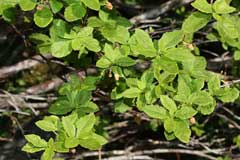 |
|
http://commons.wikimedia.org/wiki/User:Wsiegmund |
 |
| http://commons.wikimedia.org/wiki/User:Wsiegmund |
Translate this page:
Summary
Physical Characteristics

 Menziesia ferruginea is a deciduous Shrub growing to 1.8 m (6ft).
Menziesia ferruginea is a deciduous Shrub growing to 1.8 m (6ft).
See above for USDA hardiness. It is hardy to UK zone 6 and is not frost tender. It is in flower from May to June. The species is hermaphrodite (has both male and female organs).
Suitable for: light (sandy) and medium (loamy) soils and prefers well-drained soil. Suitable pH: mildly acid soils and can grow in very acid soils.
It can grow in semi-shade (light woodland) or no shade. It prefers moist soil.
UK Hardiness Map
US Hardiness Map
Synonyms
Plant Habitats
Woodland Garden Sunny Edge; Dappled Shade; Shady Edge;
Edible Uses
Edible Parts: Fruit Nectar
Edible Uses:
Fruit - fresh or dried[61, 105, 183]. The fruit is about 5 - 7mm in diameter[200]. The nectar has been sucked from the flowers to sweeten the mouth[257].
References More on Edible Uses
Medicinal Uses
Plants For A Future can not take any responsibility for any adverse effects from the use of plants. Always seek advice from a professional before using a plant medicinally.
Cardiac Poultice Stomachic
The leaves are cardiac[257]. They have been chewed to relieve heart pain and treat stomach problems[257]. A poultice of the heated leaves has been applied to sores and swellings[257].
References More on Medicinal Uses
The Bookshop: Edible Plant Books
Our Latest books on Perennial Plants For Food Forests and Permaculture Gardens in paperback or digital formats.

Edible Tropical Plants
Food Forest Plants for Hotter Conditions: 250+ Plants For Tropical Food Forests & Permaculture Gardens.
More

Edible Temperate Plants
Plants for Your Food Forest: 500 Plants for Temperate Food Forests & Permaculture Gardens.
More

More Books
PFAF have eight books available in paperback and digital formats. Browse the shop for more information.
Shop Now
Other Uses
References More on Other Uses
Cultivation details
Requires a lime-free humus-rich moist soil in sun or light shade[182]. Prefers moderate shade, especially on the roots[1, 200], but it can also succeed in full sun[11]. Grows well in a woodland garden[200]. Dormant plants are hardy to about -20°c[200]. The young growth in spring is susceptible to damage by late frosts but the plants are otherwise of easy cultivation[182]. Flowers are produced on the previous years wood[200]. Plants in this genus are notably resistant to honey fungus[200].
References Carbon Farming Information and Carbon Sequestration Information
Temperature Converter
Type a value in the Celsius field to convert the value to Fahrenheit:
Fahrenheit:
The PFAF Bookshop
Plants For A Future have a number of books available in paperback and digital form. Book titles include Edible Plants, Edible Perennials, Edible Trees,Edible Shrubs, Woodland Gardening, and Temperate Food Forest Plants. Our new book is Food Forest Plants For Hotter Conditions (Tropical and Sub-Tropical).
Shop Now
Plant Propagation
Seed - best sown in a shady position in a cold frame in the autumn[200] but it can also be sown in late winter [78]. Surface sow and do not allow the compost to become dry. Germination is variable and can take 1 - 2 months at 15°c[78]. Keep the seedlings heavily shaded and prick them out into individual pots when they are 12 months old[78]. Plant them out into their permanent positions in the summer once they are more than 15cm tall. Cuttings of semi-ripe wood, 2 - 5cm with a heel, May/June in a frame. Keep them shaded. The cuttings are very slow to root but usually a good percentage will succeed[78]. Division in early spring just before active growth begins[78]. Layering.
Other Names
If available other names are mentioned here
Native Range
NORTHERN AMERICA: Canada (Yukon (s.?), British Columbia (west)), United States (Alaska (south), Oregon (west), Washington (west), California (north))
Weed Potential
Right plant wrong place. We are currently updating this section.
Please note that a plant may be invasive in one area but may not in your area so it's worth checking.
Conservation Status
IUCN Red List of Threatened Plants Status :

Growth: S = slow M = medium F = fast. Soil: L = light (sandy) M = medium H = heavy (clay). pH: A = acid N = neutral B = basic (alkaline). Shade: F = full shade S = semi-shade N = no shade. Moisture: D = dry M = Moist We = wet Wa = water.
Now available:
Food Forest Plants for Mediterranean Conditions
350+ Perennial Plants For Mediterranean and Drier Food Forests and Permaculture Gardens.
[Paperback and eBook]
This is the third in Plants For A Future's series of plant guides for food forests tailored to
specific climate zones. Following volumes on temperate and tropical ecosystems, this book focuses
on species suited to Mediterranean conditions—regions with hot, dry summers and cool, wet winters,
often facing the added challenge of climate change.
Read More
Expert comment
Author
Sm.
Botanical References
1171200
Links / References
For a list of references used on this page please go here
Readers comment
| Add a comment |
|
If you have important information about this plant that may help other users please add a comment or link below. Only comments or links that are felt to be directly relevant to a plant will be included. If you think a comment/link or information contained on this page is inaccurate or misleading we would welcome your feedback at [email protected]. If you have questions about a plant please use the Forum on this website as we do not have the resources to answer questions ourselves.
* Please note: the comments by website users are not necessarily those held by PFAF and may give misleading or inaccurate information.
To leave a comment please Register or login here All comments need to be approved so will not appear immediately.
|
Subject : Menziesia ferruginea
|
|
|
|